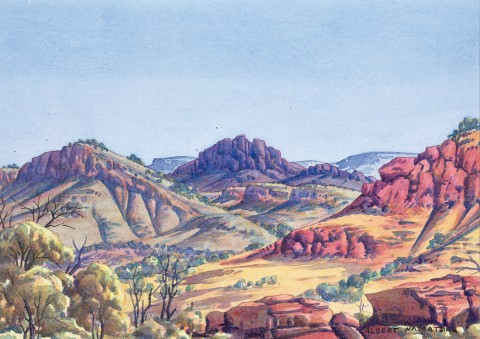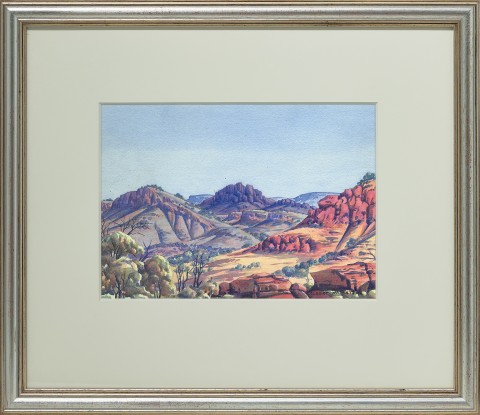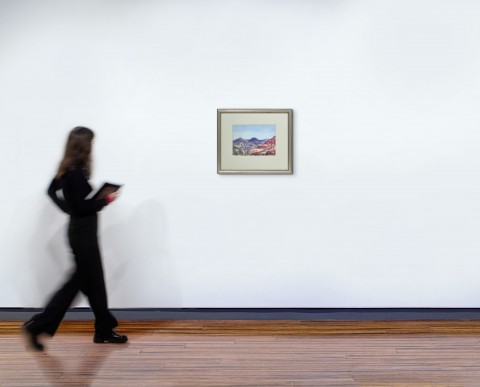LOOKING WEST FROM GLEN HELEN, 1951
ALBERT NAMATJIRA
watercolour and pencil on paper
26.0 x 37.5 cm
signed lower right: ALBERT NAMATJIRA
inscribed on sheet verso: Looking / West from / Glen Helen
Dennis Connors (Newcastle Waters Station, NT), acquired in the early 1950s
Thence by descent
Private collection, Melbourne, acquired c.1980
Thence by descent
Private collection, Melbourne, acquired in 2006
Glen Helen Country, watercolour on paperboard, 25.0 x 34.0 cm, in the collection of Ngurratjuta Pmara Corporation Collection, Araluen Galleries, Alice Springs
Albert Namatjira was a naturalist and a tonalist, whose patrilineal totemic connection to the country bordering and north of Glen Helen (Yalpalpe) and the Finke River (Lherre pirntea) formed the bedrock of his art and provided plural meanings for those viewers who could read them. Landforms as discrete entities held a certain fascination for the artist. Whether they are large mountains or monoliths on a smaller scale, they also hold spiritual meaning for the traditional owners and, as with many locations in central Australian, can be read as both ‘sights’ and ‘sites’.1
Painted in 1951, Looking West from Glen Helen observes the distant ranges far to the west of Glen Helen Gorge and appears atypical in that the viewpoint is not framed by a gum tree or rocky outcrop located in the foreground. Presenting a more open horizontal and expansive experience of the landscape, the viewpoint is nevertheless carefully controlled by the artist who directs the viewer to the distant peaks through the placement of intervening mountain slopes in the middle distance. Namatjira’s familiarity with his country is evident in these long distant views ‘where peaks and monoliths provide a rich range of possibilities and responses that arise from constantly re-engaging with the same subject.’2 They also resonate with important personal symbolism for the artist as statements of belonging – as coded expressions embodying the memory and knowledge of traditional ancestral sites, of his totemic places. Landscape artist Lloyd Rees acknowledged this duality when he observed ‘I find in his [Namatjira’s] work a marvelous sense of distance and of space. His eye can look so far away and seem to know what’s there’.3
Wenten Rubuntja, artist and Chairman of the Aboriginal Areas Protection Authority in Mparntwe, where Namatjira lived, explained the sensitivity to plural meanings required in the appreciation of Namatjira’s artworks: ‘we’re not photographers, taking pictures. The country has got sacred sites, that stone, that mountain has got Dreaming and himself is sacred country. Not just free mountain. We sing that one – we got that song. Well, the song is the history of the country. […] Albert Namatjira used whitefella’s side of the story – he painted landscape. He painted the Twerrenge (Dreaming) side there as well. Namatjira used two Laws’.4
1. French, A., Seeing the Centre: The Art of Albert Namatjira 1902 – 1959, National Gallery of Australia, Canberra, 2002, p. 93
2. ibid., p. 96
3. ibid., p. 97
4. Rubuntja, W., cited in French, A., ‘We’ve Got to Follow that Old Man’s Tracks: Engaging with the Art of Albert Namatjira’, in Perkins, H., and West, M., One Sun One Moon: Aboriginal Art in Australia, Art Gallery of New South Wales, Sydney, 2007, p. 159
CRISPIN GUTTERIDGE


